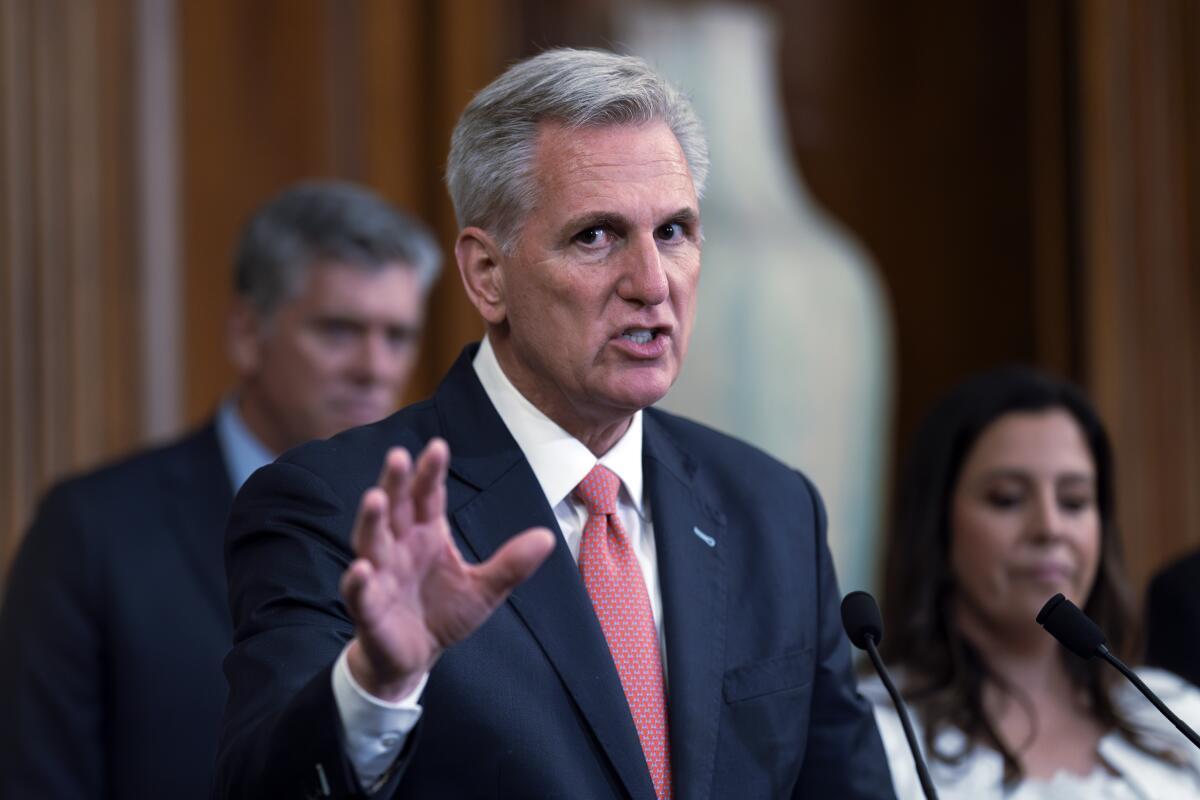Members of Congress break for August with no clear path to avoiding a shutdown this fall

- Share via
WASHINGTON — Lawmakers broke for their August recess this week with work on funding the government largely incomplete, fueling worries about whether Congress will be able to avoid a partial government shutdown this fall.
Congress has until Oct. 1, the start of the new fiscal year, to act on government funding. They could pass spending bills to fund government agencies into next year, or simply pass a stopgap measure that keeps agencies running until they strike a longer-term agreement. No matter which route they take, it won’t be easy.
“We’re going to scare the hell out of the American people before we get this done,” said Sen. Chris Coons (D-Del.).
Coons’ assessment is widely shared in Congress, reflecting the gulf between the Republican-led House and the Democratic-led Senate, which are charting vastly different — and mostly incompatible — paths on spending.
Booksellers in Hungary must decide whether to comply with a law requiring books that depict homosexuality to be placed in closed packaging on their shelves.
The Senate is adhering mostly to the top-line spending levels that President Biden negotiated with House Republicans in late May as part of the debt-ceiling deal that extended the government’s borrowing authority and avoided an economically devastating default.
That agreement holds discretionary spending generally flat for the coming year while allowing increases for military and veterans accounts. On top of that, the Senate is looking to add $13.7 billion in additional emergency appropriations, including $8 billion for defense and $5.7 billion for non-defense.
House Republicans, many of whom opposed the debt-ceiling deal and refused to vote for it, are going a different way.
GOP leaders have teed up bills with far less spending than the agreement allows in an effort to win over members who insist on rolling back spending to fiscal year 2022 levels. They are also adding scores of policy add-ons broadly opposed by Democrats. There are proposals to reduce access to abortion pills, bans on the funding of hormone therapy and certain surgeries for transgender veterans, and a prohibition on training programs promoting diversity in the federal workplace, among many others.
At a recent news conference at the Capitol, some members of the House Freedom Caucus, a conservative faction within the House GOP, said that voters elected a Republican majority in that chamber to rein in government spending and it was time for House Republicans to use every tool available to get the spending cuts they want.
“We should not fear a government shutdown,” said Rep. Bob Good (R-Va.). “Most of the American people won’t even miss if the government is shut down temporarily.”
Many House Republicans disagree with that assessment. Rep. Mike Simpson (R-Idaho) called it an oversimplification to say most Americans wouldn’t feel an effect. And he warned that Republicans would take the blame for a shutdown.
“We always get blamed for it, no matter what,” Simpson said. “So it’s bad policy, it’s bad politics.”
But the slim five-seat majority Republicans hold amplifies the power that a small group can wield. Even though the debt ceiling agreement passed with a significant majority of Republicans and Democrats, conservative opponents were so unhappy in the aftermath that they shut down House votes for a few days, stalling the entire GOP agenda.
Shortly thereafter, House Speaker Kevin McCarthy argued the numbers he negotiated with the White House amounted to a cap and “you can always do less.” GOP Rep. Kay Granger of Texas, who chairs the House Appropriations Committee, said she would seek to limit nondefense spending to 2022 budget levels, saying the debt agreement “set a top-line spending cap — a ceiling, not a floor.”
The decision to cut spending below levels in the debt ceiling deal helped get the House moving again, but put them on a collision course with the Senate, where the spending bills hew much closer to the agreement.
“What the House has done is they essentially tore up that agreement as soon as it was signed,” said Sen. Chris Van Hollen (D-Md.). “And so we are in for a bumpy ride.”
Even as House Republicans have been moving their spending bills out of committee on party-line votes, the key committee in the Senate has been operating in a bipartisan fashion, drafting spending bills with sometimes unanimous support.
“The way to make this work is do it in a bipartisan way like we are doing in the Senate. If you do it in a partisan way, you’re heading to a shutdown. And I am really worried that that’s where the House Republicans are headed,” Senate Majority Leader Charles E. Schumer (D-N.Y.) told reporters this week.
McCarthy countered that people had the same doubts about whether House Republicans and the White House could reach an agreement to pass a debt ceiling extension and avoid a default.
“We’ve got till Sept. 30. I think we can get this all done,” McCarthy said.
In a subsequent news conference, he said he’d just met with Schumer about the road ahead on an array of bills, including the spending bills.
“I don’t want the government to shut down,” he said. “I want to find that we can find common ground.”
In all, there are 12 spending bills. The House has passed one and moved others out of committee. The Senate has passed none, though it has advanced all 12 out of committee, something that hasn’t happened since 2018.
Still, the difficulty ahead was evident on the House side, where Republicans gave up until after the recess on trying to pass a spending measure to fund federal agriculture and rural programs and the Food and Drug Administration, amid disagreements over its contents. They began their August recess a day early instead of holding votes Friday.
Simpson said some of his GOP colleagues don’t want to take money approved already outside the appropriations process to cover some of this year’s spending and avoid deeper cuts. For example, the House bills would take almost all of the money approved last year for the Internal Revenue Service in Biden’s Inflation Reduction Act and use the savings to avoid deeper spending cuts elsewhere.
Simpson said that without such rescissions, as they are called in Washington, he couldn’t vote for the agriculture spending bill because the cuts “would have just been devastating.”
“That’s the challenge we’re going to have when we get back in September,” he said.
Further complicating things in the House, a few Republicans are opposed to some of the policy riders being included in the spending bills. For example, the agriculture spending bill would reverse the FDA’s decision to allow abortion pills to be dispensed in certified pharmacies, instead of only by prescribers in hospitals, clinics and medical offices.
“I had a problem with abortion being put inside an ag bill,” said Rep. Brian Fitzpatrick (R-Pa.). “I think that’s ridiculous.”
It’s a strong possibility that Congress will have to pass a stopgap spending bill before the new fiscal year begins Oct. 1. The Senate can vote first on the measure, which would put the onus on House Republicans to bring it up for a vote or allow for a shutdown.
More to Read
Get the L.A. Times Politics newsletter
Deeply reported insights into legislation, politics and policy from Sacramento, Washington and beyond. In your inbox twice per week.
You may occasionally receive promotional content from the Los Angeles Times.











